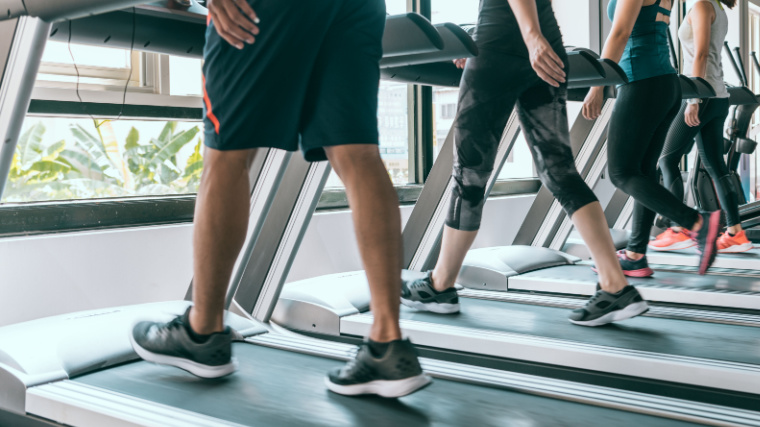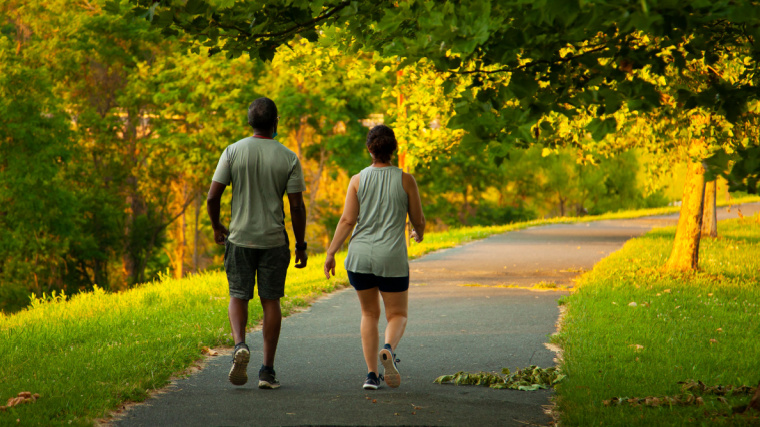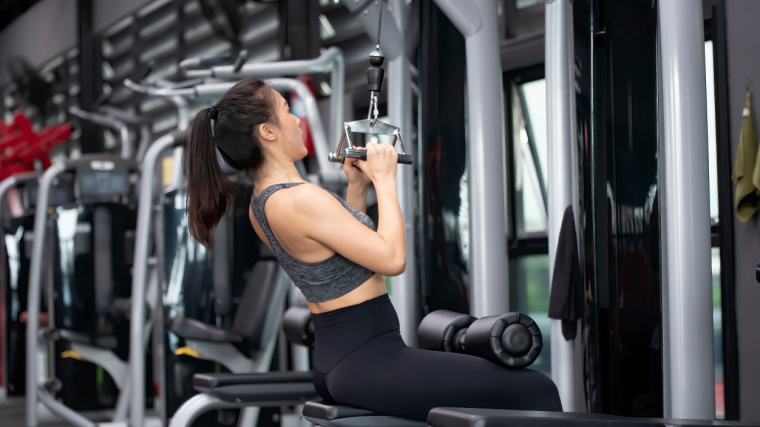Health & Fitness
Walking for Weight Loss: A Guide to Drop the Pounds
Don’t be mistaken — it’s essential that you push yourself in the gym. However, just because high-intensity interval training (HIIT) has become incredibly popular doesn’t mean it’s the only option for people who want to burn fat and lose weight.
In fact, you can trim inches off your waistline without coming close to hitting your VO2 max or feeling like you’re about to pass out on the rowing machine. While following a strength training program will allow you to build muscle, incorporating a walking protocol into your workout routine can help get rid of some extra pounds.

But just how many steps should you aim for if you want to see the number on the scale drop? This comprehensive guide covers everything from the benefits of walking to general weight loss tips to support your efforts to a step-by-step plan you can follow so you can reap the physical and mental benefits of the simplest form of cardio.
Walking for Weight Loss
Benefits of Walking
Although walking isn’t necessarily the most efficient form of exercise for hitting a weight loss goal, it can certainly be effective. Because you need to be in a calorie deficit to lose body fat, walking is one way you can ensure you’re burning enough calories to support your efforts to slim down. (1)
Of course, there’s a difference between going for a casual stroll around the neighborhood and moving at a brisk pace at an incline on a treadmill. However, the point is that you can put yourself in a better position to hit your target body weight by engaging in an activity that requires zero home gym equipment or technical expertise.
Choosing walking over rowing intervals or a weight training session may seem sacrilegious in some circles, but there are actually several reasons you may want to go in this direction (at least some of the time). Let’s take a closer look at a few of the advantages going for a walk offers.
Lower Chance of Injury
As rewarding as it may be to hit a new max on the back squat or complete a WOD in record time, high-intensity activities like weightlifting and CrossFit undoubtedly come with a level of risk.
Those forms of exercise can place tremendous stress on your tendons, ligaments, joints, and other structures. And if you don’t utilize proper form, you can quickly go from feeling ready to crush your set to suffering a setback that could keep you sidelined for a while. On the other hand, walking doesn’t come with nearly the same risk of injury.

Sure, you need to be careful about selecting a properly sized pair of shoes that provides sufficient arch support. However, you don’t have to worry about getting hurt from a complicated movement or high-intensity lift that could put you in a compromising position.
Allows You to Train for Longer Periods of Time
The short-but-sweet style of high-intensity training makes it an optimal choice for those in a time crunch. However, because these type of workouts are so anaerobically demanding, they typically only last between 20-30 minutes.
On the other hand, you can perform steady-state cardio for significantly longer and still obtain results. While it would be extremely challenging to sustain a high level of performance during a 60-minute HIIT session, you can make it through a one-hour walk without dragging at the end.
Ideal for Active Recovery
You won’t be able to achieve your weight loss goal if you don’t invest time in active recovery. After all, incorporating rest days into your routine is essential to maintaining balance and providing your muscles and joints with some short-term relief.
Walking serves a dual purpose in that it can be utilized as a form of active recovery and calorie burning. Completing a 45-minute walk on your day off from lifting will not only promote blood flow, but also provide a fat-burning and muscle-sparing stimulus. (2)
10,000 Steps Per Day: Myth or Fact?
If you have a smartphone, chances are you’ve received at least a few notifications urging you to hit your step goal before it’s too late. For some people, satisfying that 10,000-step requirement has become a staple part of their daily routine. For others, though, hitting that number represents a daunting task that seems excessive, and perhaps unnecessary.
So, who’s correct?
Ironically, the entire premise of the 10,000 steps per day idea originated in 1965 when a Japanese company developed a pedometer called the “Manpo-kei,” which translates to “10,000 steps meter.” Rooted in marketing rather than science, the idea clearly caught on big in the fitness community and has only become more prevalent as step-tracking technology in phones and watches has improved.

While taking more steps per day has been associated with lower mortality rates, there isn’t any direct evidence to support that 10,000-step mark. (3) Moreover, that goal may not be sustainable for certain groups, including the elderly and those with chronic health conditions. (4)
That being said, movement is still a major component of an effective weight-loss plan. Research shows that 225-420 minutes per week of physical activity promotes clinically significant weight loss. (5) Incorporating walking into your exercise mix will help you reach that target, and shooting for somewhere in the range of 7,500-9,000 is likely attainable for most individuals.
Overall, there’s nothing wrong with setting the bar high, but don’t feel discouraged if you fall a little shy of 10,000 steps.
Weight Loss Tips
Losing weight is both an art and a science. On one hand, there’s no one-size-fits-all approach that’s guaranteed to work for everyone. On the other hand, adhering to scientific principles like eating in a caloric deficit, consuming adequate protein, and exercising regularly will put you on the right path.
So, if your primary goal is to lose weight, here are some strategies you can start implementing immediately.
Meal Prep
Failing to prepare is preparing to fail. No phrase encapsulates losing weight quite like that one — and for good reason. Taking the guesswork out of “what’s for dinner?” will undoubtedly make life easier, especially if you have a hectic schedule. Meal prepping is easily one of the most effective ways to support your weight-loss efforts.
Depending on your caloric and macronutrient needs, you can put together a menu of breakfast, lunch, and dinner options for the week, purchase the necessary ingredients, and get your cooking done all at once so you can devote the rest of your energy to training and taking care of other responsibilities.

However, taking the day-by-day approach can cause you to stray off your dietary plan, make poor food choices, and slow down your progress.
Avoid Liquid Calories
A common mistake many people make is consuming too many calories from liquid sources. That includes drinking sugar-laden sodas and juices, or even adding unnecessary calories to your morning coffee in the form of sweeteners, syrups, and other ingredients that aren’t friendly for your waistline.
To stay on track to hit your weight-loss goal, avoid “drinking” your calories, and instead stick to calorie-free beverages like water, sparkling water, black coffee, or green tea.
That will give you more room in your caloric budget for far more satiating and nutritious options like steak, chicken, eggs, and other protein sources.
Keep a Food Journal
Holding yourself accountable is arguably the biggest key to sustained success in any endeavor. That’s no different when it comes to weight loss, where you will be rewarded for maintaining a consistent approach to your nutrition and training.
Especially when you are starting out in your weight loss plan, be diligent about documenting exactly what’s going into your body by keeping a food journal where you log everything you eat in a day. Try doing this for at least a week, so you can get a complete picture of not just what you are eating but how much you consume on a daily basis.
Lift Weights (Consistently)
Don’t fall into the trap of believing hours on the StairMaster or treadmill is the best way to lose weight. Actually, you will achieve the best results by combining cardio with strength training. That doesn’t mean you have to become a powerlifter or train like a bodybuilder, but it does mean you should incorporate weightlifting into your workout routine at least two to three days per week.

You can start with a classic push/pull/legs workout split that targets every major muscle group over the course of three training sessions. Or, you can go with an upper/lower approach where you alternate between training your quads, glutes, hamstrings, and calves on one day and your chest, back, biceps, and triceps on another day.
Sample Walking Plan
If you’re ready to stretch your legs, break a sweat, and burn some calories, this sample walking plan should serve as an excellent starting point. Keep in mind that you don’t necessarily have to stick to the treadmill to get your steps in, either. Going outside to soak up some vitamin D and breathe fresh air can make walking more enjoyable and beneficial from a health perspective.
With weight loss as the primary goal, here’s a schedule you can follow that’ll allow you to make serious strides in your journey.
- Day 1: Walk for 30 minutes at a brisk pace on a flat surface.
- Day 2: Set a treadmill to an incline level between 3 and 5 percent and walk at a brisk pace for 15 minutes. Increase the incline level by another 2 to 3 percent and walk at a slightly slower pace for another 15 minutes.
- Day 4: Start your day with a casual 20-minute walk on an empty stomach. End your day with another 20-minute walk after you’ve consumed your final meal.
- Day 5: Walk for 40 minutes at a brisk pace on a flat surface — level ground outdoors or a zero-incline treadmill.
- Day 6: Set a treadmill to an incline level between 5 and 7 percent and walk at a brisk pace for 10 minutes. Increase the incline level by another 2 to 3 percent and walk at a slightly slower pace for 10 minutes. Then, lower the treadmill to zero or one incline and finish with 10 minutes of a brisk walk.
FAQs
Like any form of exercise, it’s possible to overtrain with walking. Be mindful of your posture and your choice of footwear, as both are necessary for avoiding injuries. Also be aware of any joint pain or soreness, which could be indications of overtraining.
That said, walking can be a safe, relatively low-impact physical activity that you can (and probably should) do on a daily basis.
Although plenty of people swear by fasted cardio, research indicates that partaking in aerobic exercise with or without food does not have a significant impact on body composition outcomes. (6)
Whether you walk on an empty stomach or eat something light beforehand, it simply comes down to personal preference.
Static stretches are best performed post-activity. However, you can engage in a dynamic warm-up routine before going for a walk to increase your core body temperature, promote blood flow, and prime your muscles and ligaments for movement.
According to the American Academy of Podiatric Sports Medicine, you should replace your walking or running shoes every 300-500 miles. (7) At a rate of 30 minutes a day, five days a week, that equates to a new pair of shoes every six to 12 months.
Shin splints are one of the most common overuse injuries, especially in runners and athletes. To help prevent that painful inflammation around your tibia and shins, make sure to wear supportive shoes, incorporate rest days when needed, and slowly increase your activity level over time.
References
- Strasser, B., Spreitzer, A., & Haber, P. (2007). Fat loss depends on energy deficit only, independently of the method for weight loss. Annals of nutrition & metabolism, 51(5), 428–432. https://doi.org/10.1159/000111162
- Chomentowski, P. J., Dubé, J. J., Amati, F., Stefanović-Račić, M., Zhu, S., Toledo, F. G., & Goodpaster, B. H. (2009). Moderate exercise attenuates the loss of skeletal muscle mass that occurs with intentional caloric Restriction-Induced weight loss in older, overweight to obese adults. The Journals of Gerontology, 64A(5), 575–580. https://doi.org/10.1093/gerona/glp007
- Lee, I., Shiroma, E. J., Kamada, M., Bassett, D. R., Matthews, C. E., & Buring, J. E. (2019). Association of step volume and intensity with All-Cause mortality in older women. JAMA Internal Medicine, 179(8), 1105. https://doi.org/10.1001/jamainternmed.2019.0899
- Tudor‐Locke, C., & Bassett, D. R. (2004). How many Steps/Day are enough? Sports Medicine, 34(1), 1–8. https://doi.org/10.2165/00007256-200434010-00001
- Swift, D. L., Johannsen, N. M., Lavie, C. J., Earnest, C. P., & Church, T. S. (2014). The role of exercise and physical activity in weight loss and maintenance. Progress in Cardiovascular Diseases, 56(4), 441–447. https://doi.org/10.1016/j.pcad.2013.09.012
- Schöenfeld, B. J., Aragon, A. A., Wilborn, C., Krieger, J., & Sönmez, G. T. (2014). Body composition changes associated with fasted versus non-fasted aerobic exercise. Journal of the International Society of Sports Nutrition, 11(1). https://doi.org/10.1186/s12970-014-0054-7
- How Do I Know When It Is Time To Replace My Athletic Shoes. (n.d.). https://www.aapsm.org/replace_shoes.html
Featured Image: Day of Victory Studio / Shutterstock
Source link

